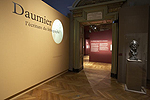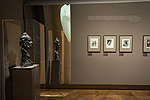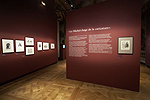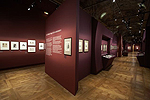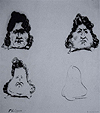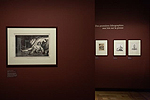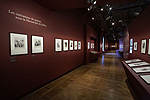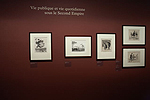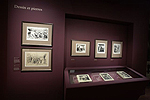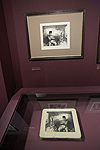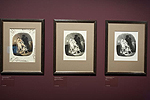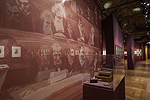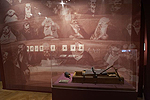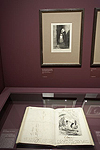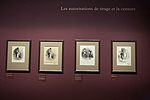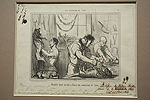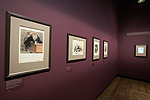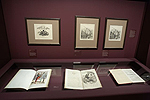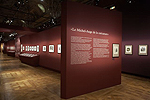The browser will either open the file, download it, or display a dialog.
|
Daumier : L’écriture du lithographe Catalogue: |
|||
|
In recognition of Honoré Daumier’s birth in 1808, the Bibliothèque nationale de France (BNF) organized one of the most thorough displays of the artist's work in decades, just steps away from where he worked as an errand boy to a bookseller in the Palais Royal. As last spring’s exhibition revealed, Daumier’s path to success was characterized not only by his uncommon talent as a lithographer, but also by his courage in tackling difficult subjects that often exposed the greed and corruption of real life. It is an impressive accomplishment for a caricaturist to have a one-man retrospective, although it must be remembered that Daumier is regarded as the “Michelangelo” of caricaturists, a point underscored by the authors of the accompanying exhibition catalogue. It is nonetheless tempting to wonder what Daumier might have thought of this exhibition at the Bibliothèque nationale where his lithographs were displayed beneath the lavish allegorical paintings created by the same artists he often saw during his frequent visits to the Louvre museum. |
|||
|
Valérie Sueur-Hermel, curator of Daumier: L’écriture du lithographe, had the daunting task of selecting 220 pieces from among the 4000 lithographs that Daumier created between 1830 and 1872. She made her choice after spending countless hours in the BNF’s rare book room scouring the vast collection of lithographs that entered the library thanks to the dépôt légal. According to Sueur-Hermel, this law was reorganized in 1810 “in a spirit of surveillance and potential censure”, and obligated any publisher of prints to give at least two copies of his work to the Bibliothèque; in 1814 that number was increased to five copies. The richness of last spring’s show is largely due to this unique collection of Daumier’s entire work, consisting of two complete sets on white paper. The library also increased its holdings of rare Daumier prints, including a number of “proofs before the letter”, the state of the actual image before any text was added by the artist or his collaborators, through donations by well-known collectors such as the American collector, Atherton Curtis, who lived in Paris in the early 1920’s, and through purchases from Parisian art dealers such as Paul Prouté, Le Garrec and Pillet. |
|||
|
The other key to the success of this year’s Daumier show was the well-planned, clearly focused installation. By dividing the exhibit into two parts, the viewer was able to first admire the artist’s career as an illustrator for the press, and secondly to understand the process of the lithographic workshop, demonstrating how Daumier was able to create thousands of works of art. The use of short films in each section also enabled the visitor to better understand the life and times of Daumier as well as his artistic accomplishments. |
|||
|
Daumier’s photographic portrait greeted visitors to the exhibition in the first gallery at the top of the red-carpeted grand staircase (fig.1). By positioning this image at the beginning of the exhibition, the curators invited visitors to recognize Daumier’s multivalent talent for social and political satire. Further supporting this impression was the self-portrait bronze bust from 1853, restored especially for the occasion and the sole sculpture in the show. This rarely seen bust further highlighted one of Daumier’s strongest artistic weapons—his independence and energy even during times of considerable personal struggle (fig. 2). |
|||
|
The show began in the main gallery by engaging the viewer immediately with the political upheaval of Daumier’s prison experience and the notorious image that caused the scandal: Gargantua, published in La Caricature December 6th, 1831. This scathing lithograph portrayed the corrupt and gluttonous Louis Philippe, King of France (1830 -1848), seated upon a toilet throne and busily devouring money from the poor, while greedy members of the government take advantage of the sinecures emerging from Louis Philippe’s rear end underneath his ‘throne’ (fig. 3). Both the publisher, Delaporte, and the print dealer, Aubert, were punished as well as Daumier and his editor Charles Philipon, for having led to the “excitation of hatred and disdain of the King’s government” by publishing a scatological image that befouled the position and importance of the king and throne. It also suggested that the reign of the July Monarchy was one of total corruption. |
|||
|
Another key satirical piece early in the exhibition was the unique ink drawing by Charles Philipon, Daumier’s employer and owner of the magazine La Caricature, who offended the government of Louis Philippe with his caricatures to such an extent that he was repeatedly thrown into jail. One of Philipon’s most offensive themes was the portrayal of the king as a pear, as seen in The Metamorphosis of King Louis-Philippe into a Pear, 24 November 1831 (fig. 4). The drawing strongly suggests that it was Philipon who invented the “poire” (pear), as a visual metaphor for Louis Philippe, drawing on the significance of graffiti and the use of the ‘poire’ on walls in Paris as a synonym for stupidity. |
|||
|
The originality of this particular piece also lies in its creation. As legend would have it, Philipon was brought to court for publishing an anti-royalist caricature, and in his defense he argued that “anything can resemble the King”. He then proceeded to draw first the King’s face, followed by three other sketches, each one with fewer and fewer character traits until the final image was a simple outline of a pear. The symbol caught on and was exploited by Daumier and other caricaturists of the time (fig. 5). |
|||
|
Other popular images from the early July Monarchy include some larger format lithographs such as the Ventre Législatif , Ne vous y frottez pas and one of Daumier’s most iconic images, Rue Transnonain, le 15 avril (fig. 6). All three were published in L’Association (1834), the journal founded by Philipon to pay off his fines on La Caricature. Ultimately, the latter would not survive, and the last plate to be printed before its temporary discontinuation was C’était vraiment bien la peine de nous faire tuer on August 27th 1835, just days before the Chambre des deputés voted the laws of September 9, limiting the freedom of the press, banning political caricature, and forcing artists to turn their attention to other subject matter. The reign of total freedom of the press was at an end, as ably discussed by Michel Melot, in his excellent essay in the exhibition catalogue. |
|||
|
The next series of caricatures, dating from 1835 to1848 under the July Monarchy, were almost entirely based upon Daumier’s satirical images of the Parisian society (fig. 7). His amusing look at its variety of inhabitants and moral standards found a welcome audience in the readers of Philipon’s other journals, notably Le Charivari with its extensive array of social mockery. Like Honoré Balzac’s series of books on La Comédie Humaine, Daumier’s caricatures cast a sharp light on the foibles and frequently dubious morality of bourgeois Paris. |
|||
|
In his series on Robert Macaire, the notorious business crook, Philipon often wrote whimsical captions while Daumier gave life to the character. The series proved to be such a success that it was printed in color as well as black and white. It also made Robert Macaire a symbol that many Parisians could understand since this type of swindler was all too prevalent—a product of a burgeoning materialistic society where many were concerned only for their own personal gain. |
|||
|
With Histoire ancienne, published in Le Charivari betweenDecember 1841 and January 1843, Daumier fully exploited his critical view of human nature, but also pioneered an original framing of his images with strong chiaroscuro produced by grattage, or scratching of the surface. In La Chute d’Icare, (The Fall of Icarus) for example, the light rays of the sun are typical of the artist’s technique of reworking the surface of the lithographic stone in order to create sharp contrasts between light and dark. Simultaneously, Daumier satirized the pitfalls of mythology by focusing on well-known classical legends, upsetting the traditional thinking about traditional heroes. |
|||
|
Similarly, his interest in atmospheric effects is evident in his series Types Parisiens, Les Baigneurs (1840) Les Locataires, Les Beaux jours de la vie (1840) and Les Bons bourgeois (1846-1849)where rain and snow are shown through the same use of scraping when he wants to portray areas of light. His ability to see something amusing in the mundane sites and activities, while also applying advanced printmaking techniques to his images, allowed Daumier’s work to be appreciated for several reasons: his wit, as well as his consummate artistry in the handling of the print medium; as Valérie Sueur-Hermel points out in her essay in the catalogue, Daumier’s imagery “l’élève au rang des peintres en noir et blanc.” (…brings him to the level of a painter in black and white). |
|||
|
Other series demonstrate his dramatic use of height variations to suggest movement, as in Les Gens de justice (1848), Les Bas Bleus and Les Divorceuses (Citoyennes, 1848). With his attention riveted on lawyers, Daumier drew on his years of experience to concentrate on the theatrical gestures of figures to create a sense of drama in the courtroom. Likewise, in his continuing work for La Charivari, Daumier found ample subjects to amuse the readers. Despite the harsh press laws, which encouraged a less biting tone, Daumier’s images retained their sharp satirical edge, a fact that was not lost on his audiences during the Second Empire (1852-1870) (fig. 8). |
|||
|
In the second part of the exhibit, Valérie Sueur-Hermel did an exemplary job of demonstrating the technique behind the creation of a lithograph. She integrated a variety of materials into the display, including a short film of contemporary Swiss artist, Daniel Bolsinga, making a lithograph. There was also an extremely rare drawing by Daumier showing the preparation for one of his few double pages for the Charivari entitled Grand défilé de l’armée qui vient d’être levée pour entreprendre la fameuse expédition de Rome à l’intérieur (1850). Three lithographic stones on display, one from the dealer Le Garrec, one from the Curtis collection and the third one from a donation by Maurice Rey from the Mariller collection, illustrate how the artist worked the stone (figs. 9, 10). |
|||
|
Also of interest were the series of déclinaisons, which permitted the viewer to see the stages involved in making such artistic works as the Bons bourgeois, across three states of a lithograph. N’approche pas la mêche de la lumière! (1864) was a first state before the letter, followed by its second state with the letter, and finally, the second state with the letter with watercolor by Edouard Bouvenne. The latter discovery was of genuine importance since no one had ever heard of this figure of considerable talent who was able to give strong coloration to certain of Daumier’s prints. Bouvenne’s presence in the show suggests that there are still other paths that can be explored for further research (fig. 11). |
|||
|
With plate number 9 from Les Bas Bleus, Madame, comment trouvez-vous cette cigarette?, visitors could observe the first state of the print before the letter, then with the addition of the hand-written caption, followed by the final impression with the caption. By demonstrating this process clearly, the exhibition also provided instruction in comprehending how a lithograph was actually executed (fig. 12, 13). |
|||
|
Other rare proofs of Daumier’s works in the exhibit included seldom seen, unpublished lithographs before the letter, originating from various collections and donations; for example, Suffrage universel-suffrage restraint (1851), unpublished and in its unique state, before the letter, was given to the Cabinet des Estampes or Bibliothèque nationale de France by Paul Prouté in 1976. It was intended to be included among other lithographs on the same subject, in 1851, such as Les Aveugles. |
|||
|
Equally rare were the works with captions written on the image itself from the recueil Laran, a precious album of 92 lithographs containing first states, before the letter with hand-written captions on the margins of the image. One of the most unusual was plate 8 from the series Les Silhouettes (1841), a first state before the letter with an annotation from a confused and aggravated journalist responsible for creating the caption: “These are impossible to do. Daumier should tell me in this case what he wanted to express.” Then below the image was the explication of the character in the final caption: Le Distrait/ cet artist revient du salon… (The Distracted: this artist returns from the salon…) These types of details further revealed how Daumier worked with his colleagues (fig. 14). |
|||
|
The authorization of certain plates also proved problematic. In one example from the images displayed with the actual signatures from the censorship office, it was sometimes possible to determine who censored a piece for commercial, rather than political, reasons, as in Manière dont on fait à Paris du saucisson de Lyon, (How Lyon sausages are made in Paris) which was refused for its grim scenes in a Parisian boucherie (butcher shop), where sausages are made of cat and dog’s meat. By electing to show how Daumier’s prints were received—and what activated the censor—viewers gained important insights into the reception of Daumier’s works at the moment they were produced (figs. 15,16). |
|||
|
The show concluded with publications in album format, such as Robert Macaire and a series of colored prints from Les Papas and Les Bons Bourgeois by Edouard Bouvenne and, finally, a negative of a photographic portrait of Daumier by Carjat. This broad cross-section of publications provided still further evidence of the dissemination of Daumier’s prints during his lifetime, as well as a glimpse of how others saw him. It brought the focus of the exhibition back towards Daumier’s character as these aspects of his personality were often sorely tested throughout his career (figs 17, 18). |
|||
|
One other aspect remains to be discussed. No matter how carefully organized this exhibition was on the walls of the Bibiothèque nationale, the only way to understand its contribution was to read the excellent catalogue. Written by authorities on Daumier (Michel Melot, Philippe Kaenel, Ségolène Le Men, and Sueur-Harmel) who understand the social history of the nineteenth century and the ways in which prints reflect the moral tone of an era, the publication reinforces what the exhibition itself had so clearly and masterfully accomplished. This catalogue should become, over the years, a valuable addition to the literature on Daumier. It also enlarges and supports a number of ideas intuitively and insightfully presented by Jean Adhémar, a former conservateur en chef at the Bibliothèque nationale during the 1950s, thus continuing the discussion surrounding the life and art of Honoré Daumier (fig. 19). |
|||
|
Sabina Fogle with Gabriel P. Weisberg and Janet Whitmore |
|||


